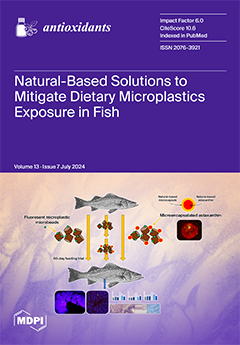Lignin nanoparticles emerged as a promising alternative for drug delivery systems owing to their biodegradability and bioactive properties. This study investigated the antimicrobial activity of the ethanolic extract of
Ocimum basilicum-loaded lignin nanoparticles (OB-LNPs) and
Lagenaria siceraria seed oil-loaded lignin nanoparticles (LS-LNPs)
[...] Read more.
Lignin nanoparticles emerged as a promising alternative for drug delivery systems owing to their biodegradability and bioactive properties. This study investigated the antimicrobial activity of the ethanolic extract of
Ocimum basilicum-loaded lignin nanoparticles (OB-LNPs) and
Lagenaria siceraria seed oil-loaded lignin nanoparticles (LS-LNPs) to find a solution for antimicrobial resistance. OB-LNPs and LS-LNPs were tested for their antimicrobial potential against
Escherichia coli,
Enterococcus faecalis,
Klebsiella pneumoniae,
Staphylococcus aureus,
Salmonella enterica,
Trichophyton mentagrophytes,
Trichophyton rubrum, and
Microsporum canis. OB-LNPs and LS-LNPs were further tested for their anti-efflux activity against ciprofloxacin-resistant
Salmonella enterica strains and for treating
Salmonella infection in a rat model. We also investigated the antifungal efficacy of OB-LNPs and LS-LNPs for treating
T. rubrum infection in a guinea pig model. Both OB-LNPs and LS-LNPs showed strong antimicrobial potential against
S. Typhimurium and
T. rubrum infections. LS-LNPs showed antibacterial activity against
Salmonella enterica species with a MIC range of 0.5–4 µg/mL and antifungal activity against
T. rubrum with a MIC range of 0.125–1 µg/mL. OB-LNPs showed antibacterial activity against
Salmonella enterica species with a MIC range of 0.5–2 µg/mL and antifungal activity against
T. rubrum with a MIC range of 0.25–2 µg/mL. OB-LNPs and LS-LNPs downregulated the expression of
ramA and
acrB efflux pump genes (fold change values ranged from 0.2989 to 0.5434; 0.4601 to 0.4730 for
ramA and 0.3842–0.6199; 0.5035–0.8351 for
acrB). Oral administration of OB-LNPs and LS-LNPs in combination with ciprofloxacin had a significant effect on all blood parameters, as well as on liver and kidney function parameters. Oxidative stress mediators, total antioxidant capacity, and malondialdehyde were abolished by oral administration of OB-LNPs and LS-LNPs (0.5 mL/rat once daily for 5 days). Interferon-γ and tumor necrosis factor-α were also reduced in comparison with the positive control group and the ciprofloxacin-treated group. Histopathological examination of the liver and intestine of OB-LNPs and LS-LNPs-treated rats revealed an elevation in
Salmonella clearance. Treatment of
T. rubrum-infected guinea pigs with OB-LNPs and LS-LNPs topically in combination with itraconazole resulted in a reduction in lesion scores, microscopy, and culture results. In conclusion, OB-LNPs and LS-LNPs possess immunomodulatory and antioxidant potential and can be used as naturally derived nanoparticles for drug delivery and treatment of Salmonellosis and dermatophytosis infections.
Full article






